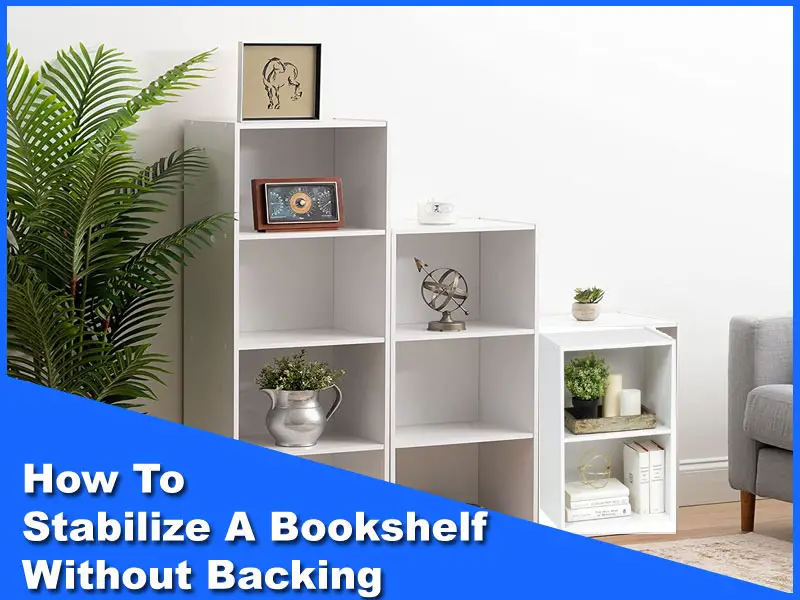A wobbly or unstable bookshelf can be a big disaster if you stack a lot of things on it. If you are living in a dorm room or a studio apartment it won’t be very easy to replace it with a new one and it can also cost you money.
So you need some good solutions to make the bookshelf stable and strong enough to hold much weight and also survive a few more years without any hassle. If you are also going through this same problem then you should check out our 5 ways how to stabilize a bookshelf without backing.
5 Ways Of How To Stabilize A Bookshelf Without Backing
If you have an old wobbly bookshelf in your room it is best to make it stable as much as possible so it does not move or tip over on you. But how can you do that? Well, we are here to guide you through 5 ways of how to stabilize a bookshelf without backing that you can use according to your choice.

1. Weight Distribution
We all know the struggle of buying a ready-made bookshelf from the stores. They are cheap but also do not have a strong structure to hold a lot of things on their own. So in that case you need to be attentive in the weight distribution process.
- Start with large items and groupings to help stabilize each shelf. Place the heavier objects like the books on the bottom shelf which will keep the weight downwards and also make the bookshelf more stable
- Mix both vertical and horizontal styling to stack books, give books more impact and height by pairing them with decorative objects
- Move the lighter objects on the upper shelves to reduce stress from the bookshelf and try not to put too much weight on the bookshelf or crowd it with a lot of things.
2. Adding A Backing To Stabilize A Bookshelf
If you have a very shaky bookshelf without backing, it is best to add one. Because a strong backing will make the bookshelf more stable and stronger in general.
Tools:
- A sheet of half-inch plywood
- Measuring tape
- Level
- Jigsaw
- Sanding paper
- Marker
- Drill
- Nails
Steps To Add Backing
- Take the measurements of your bookshelf from top to bottom and then left to right using a measuring tape
- Use a level to transfer the measurements onto the half-inch plywood sheet and mark it using a marker
- Now use the level as a straight edge to cut the plywood according to your bookshelf measurements with a jigsaw
- Now lay your bookshelf onto the ground and flip it
- Place your cut plywood onto the back of the bookshelf and make sure the plywood is aligned with the bookshelf edges and each of the corners
- Now drill the bookshelf and the plywood where nails are going to go to make sure the wood does not split
- Now nail the plywood down to the bookshelf tightly
- When you are done nailing stand up the bookshelf and tighten any loose screws
- As for the final touch sand down the edges of the plywood for any rough edges
- Lastly, ensure that the bookshelf can stand on its own
3. Install Adjustable Feet Levelers
There are different types of leg extensions available in the market that can be used for furniture. You can also add those to your bookshelf for stability. These legs are supposed to stop your furniture from wobbling or moving from its place. You can also make DIY wooden legs at home if you want.
The standard leg levelers have two sides on them; one will get attached to the bookshelf and the other will stick onto the floor. First, lay down your bookshelf on the floor. To attach the leg make four recessed holes using a drill onto the bottom of your bookshelf.
From this hole, the stud of the leg will come out. Now press your stud head through the hole far enough to be flushed with your bookshelf itself. Now place the stud hole on the other side of the bookshelf bottom so that the stud gets inside.
Now turn the leg towards the thread to tighten up the leg. You should be able to do this by your hand. Once you do get all four of the legs mounted then you can adjust it up and down to level the base of your bookshelf.
4. Anchor Your Bookshelf To The Wall
Using a tip kit to anchor your bookshelf to the wall will help prevent your bookshelf from tipping over or wobbling. It’s also very easy to assemble. For this
- Use a stud finder to find out the studs on your wall
- Mark the stud with a pencil, at the height of the bookshelf and also make the back of the bookshelf at the same height
- Move the bookshelf away from the wall and attach one bracket vertically to the wall approximately two inches under your pencil mark using the provided screws
- Then attach the second bracket horizontally to the top of the bookshelf using the provided screws
- Move the bookshelf back to the wall leaving a small gap between the brackets
- Use the given strap to fasten the brackets together, and tighten the looped strap
- Push the bookshelf back to the wall and tighten the strap again
- Now your bookshelf is securely fastened to the wall
5. Remove Everything From Underneath The Bookshelf
Oftentimes people tend to place, mats or carpets underneath their bookshelf which makes it wobbly and makes it slide. So is it always a good idea to place your bookshelf directly onto the floor so it gets its grip correctly.
You might also like
- 3 Easy Ways Of How To Clean Shellac Brush
- 3 Perfect Ways How To Measure Knee Flexion At Home
- 4 Ways How To Brace A Wobbly Table
- 8 Easiest Steps On How To Weatherproof A Picnic Table
- Perfect Way How To Measure Curling Iron
Final Verdict
If you’ve read through our 5 solutions you must be sure by now which one you want to use from our 5 ways how to stabilize a bookshelf without backing. Do let us know which one you went with and if it was effective or not.
Frequently Asked Questions (FAQ)
How To Fix Back Of Bookshelf
If your bookshelf is starting to lean back, there are a few things you can do to fix it. First, try moving the bookshelf to a different location. If that doesn’t work, try adding some weight to the bookshelf, such as by adding more books. If the problem persists, you may need to add some support to the back of the bookshelf.
You can do this by attaching a piece of wood to the wall behind the bookshelf, or by adding brackets to the back of the bookshelf.
How Do You Stabilize A Freestanding Bookcase?
A freestanding bookcase is a great way to add storage to your home without taking up too much space. But how do you keep it from tipping over? Here are a few tips:
- Use wall anchors. Wall anchors are great for stabilizing furniture and can be found at most hardware stores.
- Use furniture pads. Furniture pads are small discs that you place under the furniture legs. They provide traction and prevent the furniture from sliding around.
- Use L-brackets. L-brackets are metal brackets that you attach to the wall and furniture. They provide extra support and prevent the furniture from tipping over.
- Use heavy-duty tape. Heavy-duty tape can be found at most hardware stores. It’s great for stabilizing furniture and can be used on all types of surfaces.
- Use sandbags. Sandbags are a great way to stabilize furniture. They can be placed under the furniture legs or on top of the furniture.
With these tips, you can keep your freestanding bookcase from tipping over.
How Do You Reinforce A Cheap Bookcase?
There are several ways to reinforce a cheap bookcase. One way is to add a piece of plywood to the back of the bookcase. This will add stability and strength to the bookcase. Another way to reinforce a cheap bookcase is to add L-brackets to the corners. This will also add stability and strength to the bookcase.
How To Stabilize A Wobbly Shelf
A wobbly shelf can be a nuisance in any home. It can be caused by a number of things, including loose screws, uneven surfaces, and even a heavy object on the shelf. No matter the cause, there are a few things you can do to stabilize a wobbly shelf.
First, check to see if the shelf is level. If it’s not, try to adjust it so that it is. If the shelf is still wobbly, try tightening any loose screws. If that doesn’t work, try placing something heavy on the shelf, such as a stack of books. This will help to stabilize the shelf.
If none of these things work, you may need to replace the shelf. This is usually a quick and easy fix. Simply remove the old shelf and install a new one in its place. Make sure to follow the instructions carefully so that the new shelf is installed correctly and is level.
With a little bit of effort, you can stabilize a wobbly shelf and make it usable again.
How Do You Secure A Backless Bookshelf?
When it comes to securing a backless bookshelf, there are a few different options that you can choose from. The most important thing is to make sure that the bookshelf is securely anchored to the wall so that it doesn’t tip over and hurt anyone.
One option is to use L-brackets to secure the bookshelf to the wall. You would need to drill holes into the wall and then screw the L-brackets into place. Another option is to use heavy-duty wall hooks. You would need to drill pilot holes into the wall and then screw the hooks into place.
If you have a lot of heavy books on the bookshelf, you may want to consider using both L-brackets and wall hooks for extra security. Whichever method you choose, make sure that the bookshelf is securely anchored to the wall so that it doesn’t pose a safety hazard.
